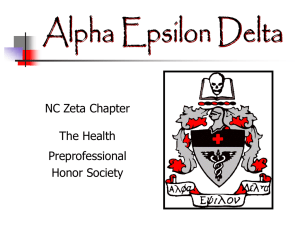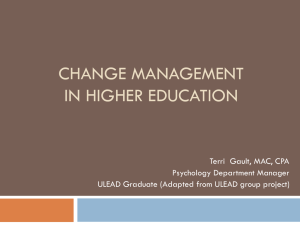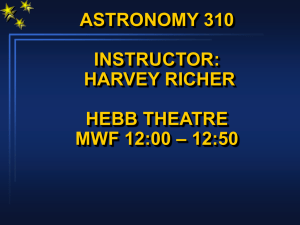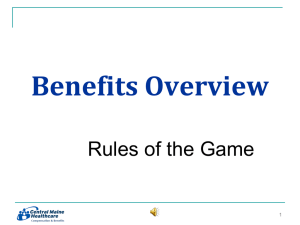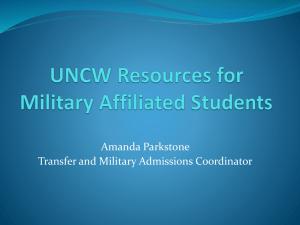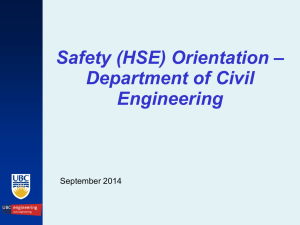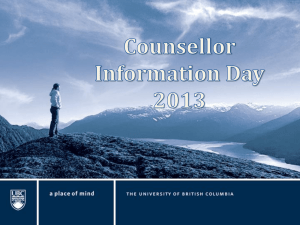2015-17 Unified Budget Process Powerpoint
advertisement
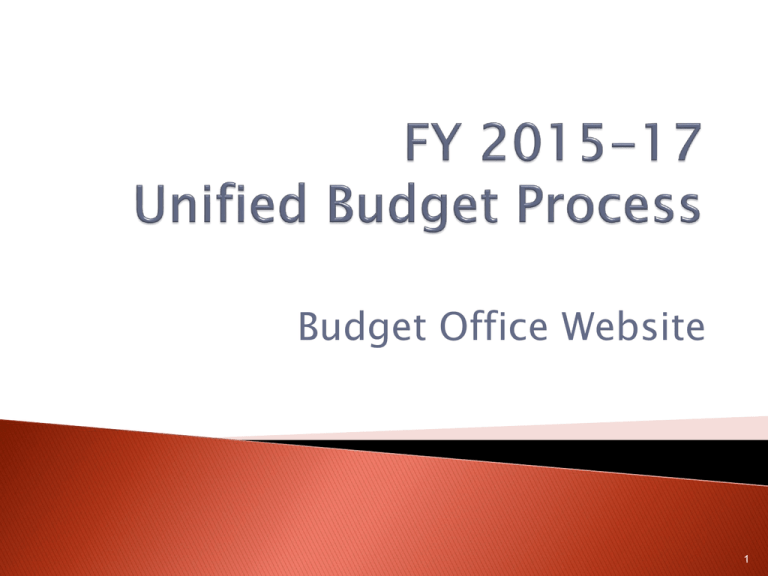
Budget Office Website 1 UNCW Budget & Planning – evolution of our processes Unified Budget Process (UBP) 2015-17 UBP Recommendations 2 2006 2011 Strategic Resource Allocations • • • • • Strategic allocations Standardization Multi-year vision Campus input Prioritization Innovation • • • • 2013 Operationalizing Strategic Decisions Innovative thinking University Innovation Council University Budget Council Restructure Tuition & Fee Advisory Committee • • • • • Unified Budget Process established Strategic decisions Quantifiable objectives Operationalizing decisions Multiple funding solutions Operationalize our strategic thinking Long-range decision-making Data-driven decisions 4 Strategic decision Operationalize decision (Unified Budget Process) Implement decision Assessment 5 UNC’s long-range planning is guided by a set of strategic directions recommended by BOG and President (UNC Strategic Directions 2013-2018) Likewise, UNCW is using strategic directions as a foundation for current and future priorities, resource planning and allocation, program development, review and refinement of our missions The Unified Budget Process fuels the achievement of these strategic decisions. 6 University Analytics 12 cell matrix Strategic Planning Program Development Budget Development Resource Determination Budget & Enrollment Planning Enrollment Management Assessment Unified Budget Process Allows university budget planning to incorporate all funding sources into the evaluation in order to optimize the allocation of funds by source. Results fed back into strategic planning process 7 Is responsive to university strategic initiatives, promotes our shared values and encourages collaboration and creativity Starts in advance of our external requirements – 1 year in advance Connects our strategic plan to UNC Strategic Directions 2013–2018 Engages the broader campus community Develops specific (quantifiable) annual objectives for strategic resource allocation - key to the process !!! UBP decisions integrate with the North Carolina biennial budget cycle ◦ Previously, the university annually conducted “budget calls” for eight (8) different budget cycles. ◦ Now UBP decisions feed the external (and internal) budget cycles 8 Year 1 of Budget Development Cycle Year 2 of Budget Development Cycle FY 2013-14 FY 2014-15 JUNE MAY APRIL FEB JAN DEC NOV OCT AUG SEPT JULY MAY FEB MARCH JAN MARCH Calendar year 2015 Calendar year 2014 DEC NOV OCT AUG SEPT JULY Calendar year 2013 JUNE FY 15 - 17 Biennial Budget APRIL University Planning, Programming & Budget Calendar University Planning - identifies strategic priorities for biennium Budgetary Programming - works w/campus to identify programs to meet strategic direction UIC proposes new initiatives that support strategic priorities Budgetary programs reviewed / analyzed by Budget Office / UBC - finalize program budgets University Analytics team provides analysis to support discussions Budget Office / UBC identify alternative sources of revenue to meet decisions Cabinet / Chancellor review / prioritize budget requirements Enrollment Management Committee develops enrollment projections Cabinet / Chancellor approve enrollment projections Annual Allocations (Permanent + One-Time Funding) Biennal Budgets (Continuation, Expansion, Capital) Enrollment Growth Projections Campus-Initiated Tuition Increases Student Fees Special Funds (Receipt-supported) Budgets Summer School Increases Supplemental Budget (2nd Year of Biennial Cycle) Mid-Year Adjustments < One-Time Allocations > 9 DEFINITION: “a budget in which the resources and services are identified by programs or function and not by the organizational units involved in performing all or part of the program and/or “functions” Strategic Planning Campus identifies strategic priorities for biennium. Ongoing initiatives are evaluated. University Analytics team provides analysis to support discussions and quantify the goals Budgetary Programming Working directly with deans and division directors -- no longer go thru divisions for data Sets out to identify those programs necessary to meet the strategic priorities Evaluate Approve External Budget Analysis Budget Office / University Budget Council (UBC) Compliance Cabinet review, prioritization & approval Analysis and Review of those programs identified by Budgetary Programming office. Finalize budgets for each program. Analyze and identify all funding sources available for each program. 10 2015-17 Strategic Planning 11 Journey of Learning Objective 1 – Meet or exceed all institutional goals in the UNC performance funding measures. ◦ ◦ ◦ ◦ ◦ ◦ ◦ ◦ ◦ ◦ Graduation Rates of NCCCS Transfer Students Degrees Awarded in STEM and Health Disciplines Undergraduate Students graduating with University Honors 6-Year Graduation Retention Degree efficiency Degrees awarded to Pell recipients Energy Efficiency Annual Giving Financial integrity index (UNC FIT) Objective 2 -Ensure that all undergraduates have an applied learning experience (in research/discovery, internships/application, service learning/regional engagement, and/or study abroad/exploration away) that achieves a set of established learning objectives. 12 Love of Place Objective 3 – Design and develop proposals for advanced health professional degree programs responsive to health industry needs. Objective 4 – Conceptualize, design and fund an industry-linked film production facility consistent with the addition of a graduate program in Film Studies. Power of Ideas and Innovation Objective 5 – Develop and implement the CREST (Millennial Campus) model with initial emphasis on meeting MARBIONC partnership targets. ◦ MARBIONC, CMS, Shellfish Hatchery Objective 6 – Enhance the regional entrepreneurial community through the launch of the Center for Innovation and Entrepreneurship and related programs. 13 Budgetary Programming 14 Each strategic objective has a program lead One of the two (2) Budget Office analysts are assigned to programs as liaison to University Budget Director Cross divisional discussions based on the program Macro-views become micro, line-item budgets 15 Strategic Goals • Ensure the proper level of resources are in place to continue to meet or exceed the established performance funding target in order to earn the available funding point. • Continue to be a performance leader in the five core business process areas of General Accounting, Contracts and Grants, Financial Aid, Capital Assets, Student Accounts. • Maintain compliancy as outlined in the UNC FIT program. • Actively participate in the ongoing development and improvement of the UNC FIT and performance funding model. GA Performance Funding Measure "UNC FIT" *FY2012-13: Score 96.5 or greater to earn 1 point for performance funding Performance Targets 1 *FY2013-14: Score 96.5 or greater to earn 1 point for performance funding *FY2014-15: Score 96.5 or greater to earn 1 point for performance funding University Budget Council (UBC) Recommendations: • Recommend with Qualifications: the UNC FIT Project Manager Officer Job description must clearly demonstrate the internal benefits of this position to UNCW. 16 • Raise funds from the private sector to further the university's mission of excellence in teaching, research, and public service • Facilitate the identification, cultivation, solicitation and stewardship of all constituencies and seek to positively promote the university • Strategically plan to ensure that gifts from our donors have the greatest impact possible Strategic Goals GA Performance Funding Measure "Annual Giving" *FY2012-13: $8,216,000 1 *FY2013-14: $8,297,000 *FY2014-15: $8,545,000 2 Increase the amount in major gift commitments by 5% annually. Performance Targets 3 Increase the amount in planned gift commitments by 5% annually. 4 Increase the amount of gifts generated by the annual giving program by 3% annually. 5 Increase the number of alumni donors by 2% annually. University Budget Council (UBC) Recommendations: • Recommend with Reservations: the expectation is that these positions would be incorporated into the strategic plan for Advancement to reduce their reliance on state appropriations and move to alternative funding in the longterm. • The UBC recognizes that this could be a 10+ year plan and there is a current need for this request. 17 • Data collection including accurate measurement and analysis of electricity, fossil based fuels, and water usage to benchmark and to allow for regular review of costs and performance • Annual summary that reviews activity related to Energy Supply, Energy Demand, Strategic Goals Communication and Training, and Water consumption • Initiate a 2nd Performance Contract project • Displacing purchased water for irrigation with well water and maximizing sewer credits GA Performance Funding Measure: Energy Efficiency (FY2011-12 Base: 111,447 Btu per sq. ft., 31% under 2002) Performance Targets *FY2012-13: 109,480 (32% under 2002) *FY2013-14: 107,820 (33% under 2002) *FY2014-15: 106,260 (34% under 2002) University Budget Council (UBC) Recommendations: • Full Recommendation for the following items: Performance Contract #2, Replacing Lighting – Warwick & Facilities Support Buildings, and Replacing Chilled Water Control Valves in Randall Library & DeLoach Hall. • Recommend with Qualifications: The funding of the Retro-commissioning should be conditional on the availability of R&R/State funding so as not to compete with other university initiatives. 18 Student Success: 1. 2. 3. 4. 5. 6. 7. Graduation Rates of NCCCS Transfer Students Degrees Awarded in STEM and Health Disciplines Undergraduate Students graduating with University Honors 6-Year Graduation Retention Degree efficiency Degrees awarded to Pell recipients These 7 measures are being analyzed as one program. Expect initial evaluations by fall 2014. 19 Strategic Goals • Provide evidenced-based opportunities to enhance the undergraduate experience and to prepare students for success in lifelong learning after graduation through international programs, faculty-mentored student scholarship, internships, eTEAL initiatives; • Ensure that 100% of UNCW students take an Exploration Beyond the Classroom experience as part of University Studies. • Encourage students to engage in multiple high-impact applied learning experiences, which correlate to a higher rate of retention and graduation. #1 #2 #3 #4 Performance Targets #5 #6 #7 #8 Exploration Beyond the Classroom (EBC): By 2016, 95% of undergraduates will have an EBC, 97% by 2017, 100% by 2018 High-Impact for-credit Applied Learning (AL): By 2017, 25% of all UNCW students will participate in an individualized or study abroad (high-impact) AL experience. Multiple AL Experiences: By 2017, 25% of all UNCW students will have multiple AL experiences, 35% by 2020 Non-Credit Bearing Applied Learning (AL): after initial baseline data is collected in 2014-2015, we will work toward a 10% annual increase in student participation through 2017. Honors College (GA performance funding): number of students in a chort that complete 499 and graduates within 4 years. 89 students by 2014 for cohort 2010-11, 92 students by 2015 for cohort 2011-12, and 95 students by 2016 for 2012-2013 cohort Center for the Support of Undergraduate Research and Fellowships: Increase number of Undergraduate Research Scholars by 5%/year Increase effective applied learning instruction for faculty, staff, and graduate student development through the Center for Teaching Excellence (CTE) Experiencing Transformative Education through Applied Learning: 172 funded eTEAL-supported Pedagogy Initiatives by 2019 University Budget Council (UBC) Recommendations: • Full Recommendation: Institutional support is highly encouraged while continuing to monitor the increase to faculty workload as the program is implemented. The program consists of 8 distinctive subprograms each with individual performance targets that can be funded separately. 20 Strategic Goals Performance Targets BOG Strategic Objectives 2013-2018 • Invest in game-changing research to create value and solve significant problems. • Develop plans to identify opportunities, recruit and retain talent, and assess infrastructural needs. • Directly engage with specific needs of constituencies throughout the state of North Carolina. • Train the next generation of medical professionals. • Rethink outdated models of health care. 1 GA Performance Funding Measure "Degrees Awarded in STEM and Health Disciplines" *FY2011-12 (Baseline): 748 degrees (213 Health degrees) *FY2012-13: 770 degrees (>=226 Health degrees) *FY2013-14: 785 degrees (>=235 Health degrees) *FY2014-15: 800 degrees (>=244 Health degrees) University Budget Council (UBC) Recommendations: • Recommend with Reservations: external consultation as part of the advanced planning phase will assist in objectively defining the program, selecting the optimal facility location and providing alternative architectural solutions. Funding is available for hiring of external consultants only. • Recommend with Reservations: external consultation for market analysis and risk assessment to best determine new proposals for advanced health professional degree programs responsive to community and regional health industry needs. Funding is available for hiring of external consultants only. 21 Strategic Goals • Prepare students, through direct hands-on experience, with the essential skills for life and career (applied learning). • Engage in collaborative initiatives and learning with industry-linked film innovators and production personnel. • Create an environment and culture to promote innovation and incubation. Performance Targets Improve graduation and retention rates. University Budget Council (UBC) Recommendations: • Recommend with Reservations: external consultation as part of the advanced planning phase will assist in objectively defining the program, selecting the optimal facility location and providing alternative architectural solutions. Funding is available for hiring of external consultants only. • Consultation results will determine which option is most feasible. 22 Strategic Goals M1 M2 Performance Targets Provide a state-of-the-art collection of faculty, students, staff and facilities to foster the highest quality of business consortia work. The process of translating basic science through applied work and iteratively into products is the ultimate goal. Populate the MARBIONC building with businesses: Add 1 business per quarter through December 2016 Develop QEP and DIS Programs to create a mechanism to organize student opportunities: Place students in 5 labs by the end of FY 2014-15, add an additional 5 students by the end of FY 2015-16 Develop translational process, products: take discovery to businesses on a monthly basis to promote university and corporate interactions Create opportunities for new discovery to translate plan for translational sciences paradigm: Hold M4 professional training sessions for faculty and student development M3 University Budget Council (UBC) Recommendations: • Recommend with Qualifications: enhanced faculty and student involvement, as well as an integrated applied learning aspect, should be achieved as a result of receiving additional funding. This should be tracked on an annual basis as the program progresses. 23 Strategic Goals CMS1 CMS2 CMS3 Performance Targets CMS4 CMS5 Provide a state-of-the-art facility to foster research programs of the highest quality, thereby enhancing educational opportunities and experiences for students, and serving as an important node for technology transfer and public service Establish PhD in Coastal and Marine Science Program at UNCW by the end of FY 2015-16 Formalize Marine Science Program at UNCW, including the establishment of a unified program by the end of FY 2014-15 and hiring of faculty, staff and students who embrace UNCW'S role as the "Coastal University". Create plan with Advancement to expand research support for graduate students, establish a marine research internship program, and enhance the CMS Postdoctoral program by the end of FY 2015-16 Working with General Administration on the Establishment of North Carolina Marine Science Consortia to promote statewide collaboration by June 2014; Establishment of Interinstitutional PhD Program by Fall 2017; in reponse to the 2013 AAAS Review of the Marine Sciences in the State of North Carolina Through infrastructure, programs and services expand the Research Effectiveness and Capabilities of CMS to meet demands of 1-3 multidisciplinary programs to increase F&A generation University Budget Council (UBC) Recommendations: • Performance Targets CMS1 – CMS4: further university level direction and prioritization is needed. These items are predicated on the approval from General Administration and/or program expansion. Do not recommend funding at this time. CMS1: Establish PhD in Coastal and Marine Science Program at UNCW CMS2: Formalize Marine Science Program at UNCW CMS3: Expand and Enhance research support and Internship & Postdoctoral Programs CMS4: Establish North Carolina Marine Science Consortia & Inter-Institutional PhD Program • Performance Target CMS5 – Full recommendation based on immediate needs for enhancing faculty research programs for greater grant competitiveness 24 Strategic Goals SRH1 SRH2 Performance Targets SRH3 SRH4 SRH5 To establish an efficient and productive facility and programs that will facilitate the fulfillment of the SRH Mission Execute selective breeding of oyster lines and evaluate performance in field trials at multiple locations by June 2014; Maintain 4 even year and 4 odd year lines, culling and initiating new as performance merits. Successful completion of production cycles and field train with partnership with industry. Produce 2 triploid cohorts/production cycle and evaluate performance. Increase to 4 cohorts/production cycle by March 2016. Maintain a student workforce of 12 student at 10-20 hours per week Execute 2-4 spawns (as needed to provide adequate material for experiments) of scallops and explore best practices for scallop grow out. Engage in outreach, seminars and conferences, develop resources for communicating the activities of the SRH, and provide the necessary research materials to students and colleagues to increase impact of SRH University Budget Council (UBC) Recommendations: • Recommend with Qualifications: enhanced faculty and student involvement, as well as an integrated applied learning aspect, should be achieved as a result of receiving additional funding. This should be tracked on an annual basis as the program progresses. 25 Removed from the UBP process Being handled separately since no university funding will be used to support program 26 Strategic Goals Performance Targets • Embrace emerging technologies and advance knowledge to transform the university and meet the needs of a diverse and changing society • Leverage new technologies to assist in achieving the desired university Strategic Action Plan Increase wireless capacity in every academic and administrative building to a maximum of up to 1 300+ Mbps 2 Increase wireless capacity in every residence hall to a maximum of up to 300+ Mbps 3 Increase capacity to desktops to a maximum of up to 1000 Mbps (1 Gbps) University Budget Council (UBC) Recommendations: • Full Recommendation: all potential funding resources should be analyzed and the best method utilized for this university level initiative. 27 Budget Analysis 28 AMOUNT Permanent Objective Performance Target One-Time BUDGET CYCLE Total Amount Biennial Biennial Biennial Supplemental Capital / Continuation Expansion Budget R&R CITI Student Summer Trust/ Enrollment ETF O/H Endowment Fees School Receipt Growth Enrollment Growth (P) University Reserves (O) Lapsed Benefits (O) Excess Utilities (O) Excess Tuition (O) Carry Forward (O) Item Requested OBJ 2: Applied Learning (AL) PT1: 100% of Undergrads will have an Exploration Beyond the Classroom (EBC) by 2018 University Studies Director PT2: By 2017, 25% of UNCW students will participate in a High-Impact for-credit AL PT2a: Credit-Bearing Study Abroad - increase # of students by 1% each year Program Leader Stipends (50 stipends) Student Study Abroad Support Global Liaisons (8 discipline specific) Graduate Assistants PT2b: Credit-Bearing Study Abroad - increase # of students by 1% each year Internship Graduate Assistant (2) PT3: By 2017, 25% of UNCW students will have multiple AL experiences Applied Learning Coordinator PT4: Non-Credit Bearing AL, work towards 10% annual increase in student participation Early College Summer Leadership & Civic Engagement Camp ePortfolio/Co-Curricular Record Software PT5: Honors College (GA Performance Funding Measure) Undergraduate AL Research Mentors (10 students) Departmental Advising (3 faculty member dept liaisons) HON 120- transfer students (faculty overload pay) HON 399- preparing for dept honors (faculty overload pay) 491/499 Research Supplies PT6: Center for the Support of Undergraduate Research Scholars (CSURF) CSURF Awards (50 awards) CSURF Faculty Associate CSURF Student Travel Awards PT7: Center for Teaching Excellence (CTE) Graduate Teaching Assistant CTE Faculty Associate PT8: Experiencing Transformative Education through Applied Learning (ETEAL) ALTC Faculty Fellows (4 faculty members overload pay) Annual Allocation $ 988,282 $ 20,400 $ 1,008,682 √ √ $100,000 $200,000 $88,000 √ √ √ √ $0 $22,000 √ √ 51,666 $3,000 $54,666 √ √ √ √ $ $ 4,500 25,000 $0 $0 $4,500 $25,000 √ √ √ √ $ $ $ $ $ 5,000 1,803 1,640 1,640 20,000 $0 $0 $1,200 $1,200 $0 $5,000 $1,803 $2,840 $2,840 $20,000 √ √ √ √ √ √ √ √ √ √ √ √ √ √ √ √ √ √ √ √ $ $ $ 250,000 40,343 50,000 $0 $0 $0 $250,000 $40,343 $50,000 √ √ √ √ √ √ √ √ √ √ √ √ $ $ 11,000 40,343 $11,000 $40,343 √ √ √ √ √ √ √ √ √ $0 $ 19,237 $0 $19,237 √ √ √ √ √ $ 56,110 $15,000 $71,110 $ $ $ 100,000 200,000 88,000 $0 $0 $0 $ 22,000 $ √ √ √ √ √ √ √ √ 29 FTE Performance Objective Target Item OBJ 1: Performance Funding - FIT PT1: GA Performance Funding Measure - Financial Integrity (UNC FIT Composite Index) UNC FIT Project Management Officer Perm (P), OneOperating (O) or Time (O) or Capital ( C) Endowment ( E) 2014-15 2015-16 2016-17 2017-18 2018-19 2019-20 EPA P O O O P O P O O O O O $ $ $ $ 90,516 2,500 77,483 2,500 1.00 P O O O $ $ 63,008 2,500 1.00 P O $ 58,011 $ $ 89,586 5,500 SPA Faculty 1.00 OBJ 1: Performance Funding - Annual Giving PT1: GA Performance Funding Measure (all items requested tie to this measure) PT2: Increase Major Gifts Commitments Major Gifts Development Director Junior Level Corporate and Foundation Relations Officer 1.00 PT3: Increase Amount in Planned Gift Commitments PT4: Increase Amount of Gifts Generated by Annual Giving Program Development Officer for Annual Giving PT5: Increase the number of Alumni donors Alumni Relations Program Assistant 1.00 30 Evaluation & Approval 31 Cabinet review, approval, prioritization Budget Office analyzes funding sources Cabinet makes final decisions - FY 14-15 funding - FY 15-17 budget cycle 32 Funding decisions made throughout the UBP feed into one, or more, of these budget cycles Budget Processes Biennial Budget Continuation Expansion Capital Supplemental Budget Campus Initiated tuition increase (CITI) Students Fees Summer School Tuition & Fees Annual Allocation Process Budget "call" to the Campus Yes No Limited x x x x x x x x 33 Year 1 of Budget Development Cycle Year 2 of Budget Development Cycle FY 2013-14 FY 2014-15 MAY JUNE APRIL MARC H JAN DEC NOV OCT SEPT AUG JULY MAY JUNE JAN FEB Calendar year 2015 Calendar year 2014 FEB DEC NOV OCT AUG SEPT JULY Calendar year 2013 APRIL FY 15 - 17 Biennial Budget MARC H University Planning, Programming & Budget Calendar University Planning - identifies strategic priorities for biennium Budgetary Programming - works w/campus to identify programs to meet strategic direction UIC proposes new initiatives that support strategic priorities Budgetary programs reviewed / analyzed by Budget Office / UBC finalize program budgets University Analytics team provides analysis to support discussions Budget Office / UBC identify alternative sources of revenue to meet decisions Cabinet / Chancellor review / prioritize budget requirements Enrollment Management Committee develops enrollment projections Cabinet / Chancellor approve enrollment projections Annual Allocations (Permanent + One-Time Funding) Biennal Budgets (Continuation, Expansion, Capital) Enrollment Growth Projections Campus-Initiated Tuition Increases Student Fees Special Funds (Receipt-supported) Budgets Summer School Increases Supplemental Budget (2nd Year of Biennial Cycle) Mid-Year Adjustments < One-Time Allocations > 34 ? 35
